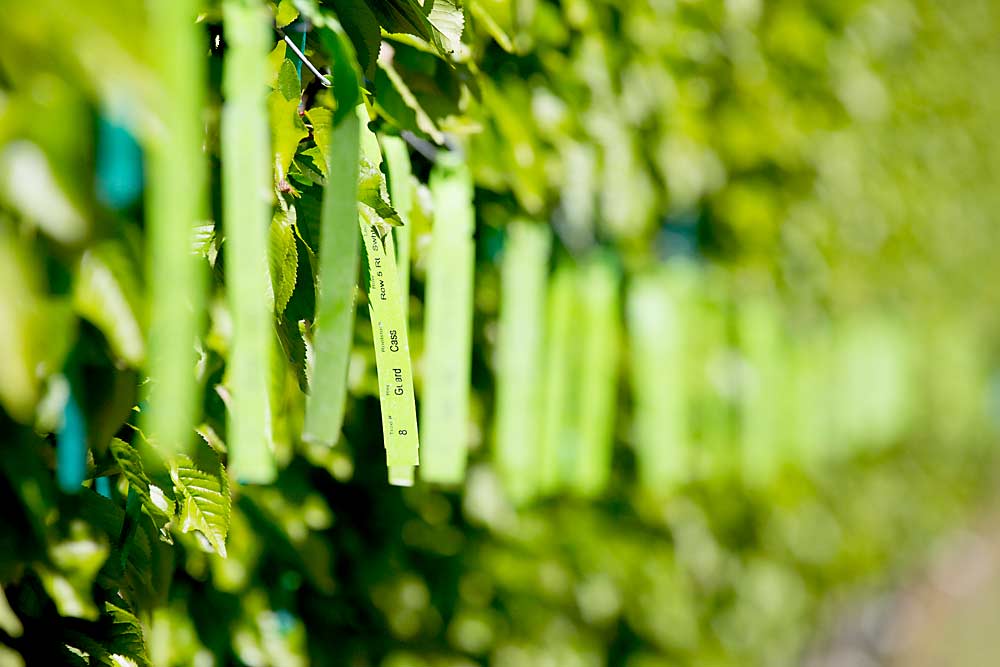
The most popular rootstock with sweet cherry growers right now, according to nurseries, is Gisela 12.
Jim Adams, vice president of Willow Drive Nursery in Washington, said Gisela 12 is the top rootstock sold by his nursery, followed by Gisela 6 and Krymsk 5.
Dave Weil, owner of Tree Connection in Oregon, said growers used to prefer Gisela 6 but now prefer Gisela 12 because of its increased vigor, which helps it better overcome stress. Krymsk 6 and 5 also are popular, he said.
Gisela 12 and 6 are the most in-demand rootstocks at Mike & Brian’s Nursery in Washington. Demand for Gisela 12 has been outpacing Gisela 6, which is less vigorous and tends to overset fruit with some varieties, resulting in smaller fruit size. Maxma 14 and Krymsk 5 and 6 also are popular, said manager Bennett Mayo.
At California’s Sierra Gold Nurseries, Mahaleb tops the rootstocks sold to California sweet cherry growers, who aren’t as far along in higher-density plantings as Washington growers, who prefer Gisela 12 and 6. Krymsk 5 and 6, Maxma 14 and Mazzard rootstocks also sell well, said director of sales Brent Burky.
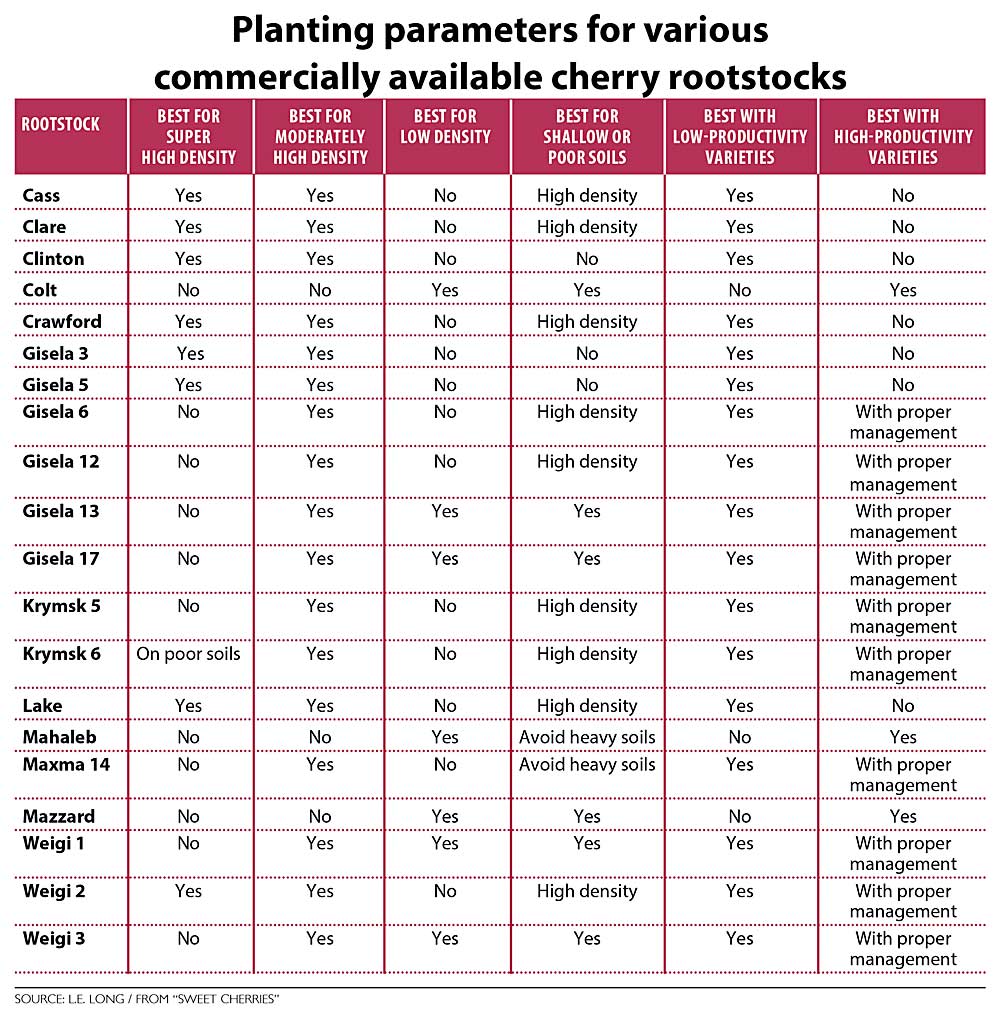
Lynn Long, a retired Oregon State University Extension horticulturist and co-author of the book “Sweet Cherries,” said Mazzard is still used extensively with some varieties and is still popular in some cherry production areas. The more precocious Krymsk rootstocks, and perhaps Gisela 13 and 17, might have potential to replace Mazzard in situations where growers have not been comfortable with the more productive Gisela 6 and 12 rootstocks, he said.
Weil said the sweet cherry industry needs a variety of rootstocks to choose from, in order to adapt to different challenges. To deal with a shrinking labor pool, new cherry plantings need to be as compact and efficient as possible. That means smaller trees, so fruit is close to hand, and no ladders. And with temperatures rising in the Pacific Northwest and California, rootstocks must withstand heat stress. Nurseries are trialing new rootstocks to deal with these challenges, but new roots take years to vet, especially when trying to match them with the ideal variety and growing system, he said.
Long said the Pacific Northwest sweet cherry industry still lacks a true dwarfing rootstock. The region’s hot summers cause performance issues for the size-controlling Gisela 5 and 3. To achieve higher densities, most Washington and Oregon growers plant semidwarfing rootstocks at tighter spacings and use training and pruning to control size, he said.
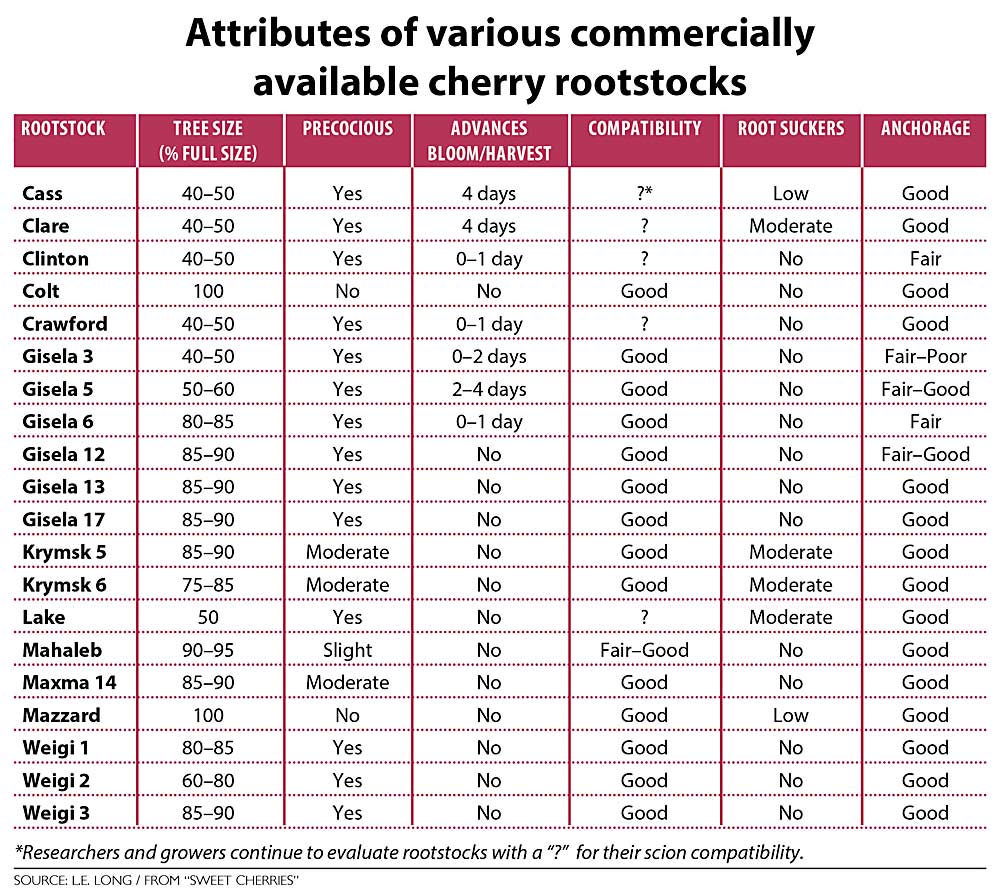
Nurseries are studying Michigan State University’s Corette series of dwarfing rootstocks, a recent introduction. Weil said the Corettes are extremely dwarfing and precocious, to the point where they tend to “shut down” by overproducing. Researchers and growers are still figuring out how to manage them, he said.
The Weigi series of rootstocks is being studied, too. Growers in Europe are abandoning them because they don’t produce well and are sensitive to disease, but they might perform differently in the Pacific Northwest, Weil said.
Corette, Weigi and dozens of other rootstocks still in the research pipeline need more testing in U.S. growing regions, Burky said.
A root review for sweet cherries

The book “Sweet Cherries” by Lynn Long, professor emeritus at Oregon State University, Greg Lang of Michigan State University and Clive Kaiser of OSU, has recently been published by CABI as part of their Crop Production in Horticulture series. The book was written for beginning and established fruit growers, consultants and advisors, with a primary focus on fresh market sweet cherries. It provides comprehensive coverage of sustainable sweet cherry production, including global trends, improved varieties and rootstocks, orchard establishment and management, the physiology of growth and cropping, and protecting the crop from adverse climates, pests and diseases.
The authors emphasize sweet cherry production practices based on scientific principles, with generous illustrations throughout. They provide a foundational understanding of cherry tree growth and fruit development as the basis for grower decisions on the many choices of ever-evolving orchard practices and emerging challenges across diverse growing conditions and environments.
With the permission of CABI, Good Fruit Grower is sharing a condensed excerpt on currently available rootstocks.
In the U.S. and other North and South American locations, the book can be ordered from: styluspub.presswarehouse.com/browse/book/9781786398284/Sweet-Cherries or from amazon.com. In the rest of the world, order the book directly from CABI at: cabi.org/bookshop/book/9781786398284.
Cherry growers have an assortment of rootstocks to choose from, ranging in size from vigorous to fully dwarfing. The advantage of size-controlling rootstocks over full-size roots is that they allow growers to plant high-density orchards that become profitable more quickly, are more readily protected with coverings and promote greater labor efficiency.
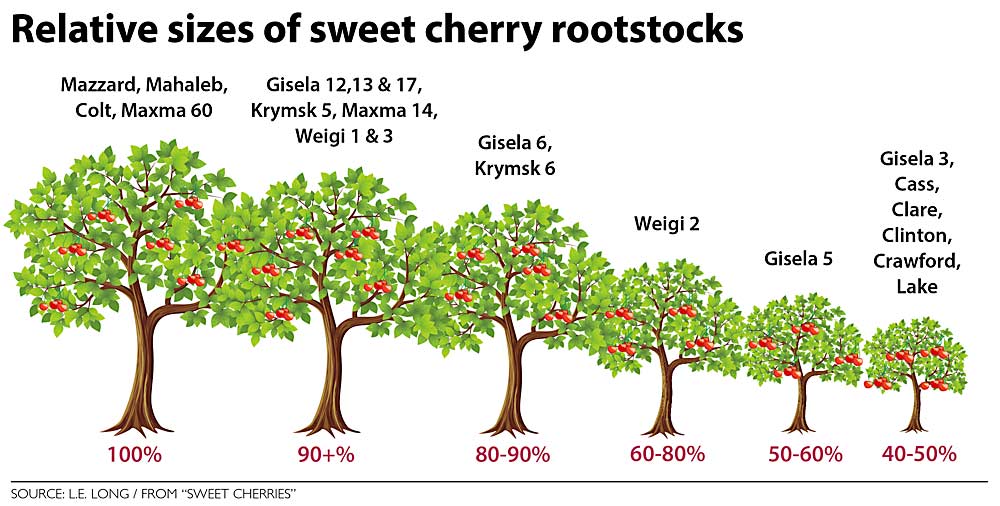
Of course, no single rootstock can satisfy all the requirements for consistently producing high yields of large, firm, premium-quality fruit. Selecting the proper rootstock depends on scion, training system, climate and soil, as well as the management skills of the grower.
The following is a list of rootstocks currently in use or being evaluated in major cherry production areas around the world:
Vigorous to semi-vigorous
CAB 6P
A clonal selection of tart cherry that makes a vigorous, somewhat precocious rootstock for sweet cherry. Trees have good anchorage. Used mainly in Italy and Chile, though recently it has fallen out of favor in Chile due to high sensitivity to bacterial canker.
Colt
In the Pacific Northwest, Colt produces a vigorous tree that is similar in size to Mazzard with similarly low precocity. Sensitive to “droughty” soils and cold winter temperatures. Grows well in a wide range of soils and can tolerate short periods with high water tables. Trees have good anchorage. Easily propagated but also prone to suckering. Colt has been planted widely in California due to its resistance to cherry stem pitting. It also has shown some resistance to phythophthora root rot, bacterial canker and gopher damage but is susceptible to crown gall.
Gisela 6
Widely planted in many production regions around the world. Productive, precocious and easy to manage. Begins producing harvestable crops by third leaf, with full production possible by fifth leaf. Due to high production levels, trees need to be properly pruned from an early age to maintain fruit size and quality. Premium fruit quality is possible with cultivars of moderate to low productivity but is more difficult with very productive cultivars. It is imperative to maintain adequate levels of vigor to produce high-quality fruit. The promotion of new shoots is much easier to achieve with Gisela 6 than Gisela 5.
Gisela 6 tends to advance flowering and fruit ripening only slightly compared to Mazzard. Trees are open and spreading with good branching. Anchorage can be a problem. Well suited to a wide range of soil types from light to heavy, but good drainage is essential. Not prone to suckering. Bacterial canker more prevalent than on rootstocks of similar vigor.
Gisela 12
Trees on Gisela 12 are variably semi-vigorous depending upon cultivar. Gisela 12 is both precocious and productive, producing early heavy crops with full production possible by fifth leaf. Good fruit size and quality is possible with proper pruning. Adapted to a wide range of soils, resists suckering and is well anchored. Tree structure is open and spreading, and new branches form readily. Scion compatibility has not been a problem.
Gisela 13
A recently commercialized clonal rootstock in need of widespread site evaluation. Sweet cherry trees on Gisela 13 are semi-vigorous, precocious and productive, develop horizontal branch angles, have good anchorage and no suckering. No reports of incompatibility problems.
Gisela 17
A recently commercialized clonal rootstock in need of widespread site evaluation. Vigorous, precocious and productive. Trees develop horizontal branch angles, have good anchorage, no suckering and are adaptable to a wide range of soil and climatic conditions. Compatibility with cultivars has been good.
Krymsk 7
A recently commercialized clonal rootstock in need of widespread site evaluation. The most vigorous of the Krymsk rootstocks to date, producing a tree slightly smaller than or similar in size to Mahaleb. Precocity is moderate, with production beginning in third or fourth leaf. Has good anchorage, minimal suckering and is tolerant to prune dwarf virus (PDV) and prunus necrotic ringspot virus (PNRSV).
Krymsk 5
A precocious, semi-vigorous clonal rootstock that results in trees comparable in size to Gisela 12, though with somewhat less precocity and yield. Adapted to a wide range of soil types. Well adapted to cold and dry climates and reported to perform well in hotter climates. Trees are well anchored and do not need support. Suckering from the crown is low to moderate, especially in heavy soils. Suckers growing from the roots are minimal. Tree form is excellent with wide branch angles and good shoot formation throughout. Hypersensitive to PDV and PNRSV, but orchard losses to such infections have thus far been minimal.
Krymsk 6
Produces a tree that is semi-vigorous, with a similar level of vigor as Gisela 6. Not as productive as Gisela 5, 6 or 12, it is more productive than Krymsk 5. Seems to be adapted to both cold and hot climates as well as heavier soils. Trees are well anchored, but there is low to moderate root suckering that in some soils can become excessive. Tree form is good, with wide crotch angles and good branching. Hypersensitive to PDV and PNRSV, but orchard losses to such infections have thus far been minimal.
Mahaleb
The typical rootstock of tart cherry growers. Usually a seed-propagated rootstock that is slightly more precocious and slightly less vigorous than Mazzard. Cold hardy and one of the most drought-tolerant cherry rootstocks, having deep roots. Extremely sensitive to waterlogged and poorly drained soils, as it is susceptible to phytophthora root rot, oak root fungus and root-knot nematode. Best suited to deep, well drained loams and sands, as well as calcareous soils. Some sweet cherry cultivars such as Chelan, Tieton and Lapins can be incompatible with Mahaleb, with decline appearing up to six years after planting. Mahaleb is attractive to gophers.
Maxma 14
A semi-vigorous clonal rootstock producing a tree intermediate in size between Mazzard and Gisela 6. Not recommended for super high-density training systems but could do well with KGB or UFO systems. Good scion compatibility and a broad adaptation to soil types and environmental conditions, although trees do best on sandier, lighter soils and will die in areas with high water tables. Trees have good anchorage and very little suckering. Tree form is open but branching has been inadequate at times. Attractive to gophers.
Maxma 60
A vigorous clonal rootstock grown in limited areas around the world, producing well-anchored trees similar in size to Mazzard, but with greater precocity and excellent fruit size. Moderate resistance to bacterial canker, and some resistance to phytophthora, crown gall and replant disease has also been reported. Adaptability to a range of soil types has been good.
Mazzard
A seed-propagated rootstock that’s well adapted to Pacific Northwest soils, is winter hardy and graft compatible with all cultivars. Due to high vigor and moderate productivity, premium fruit quality can be obtained with only moderate pruning and management. Lacks precocity, often not coming into production until fifth or sixth leaf. Vigorous growth makes it difficult to control in high-density plantings, and large tree size greatly limits picker efficiency and increases worker hazards. Does well in a wide range of soils, though performs poorly in slow-draining or wet soils. Tree anchorage is excellent, with occasional root suckers.
Mazzard F.12/1
A clonally propagated, vigorous selection of Mazzard. Less susceptible to bacterial canker than Mazzard. Performs best on fertile, irrigated soils and should not be planted on light or heavy soils. High susceptibility to crown gall.
Weigi 1
A recently commercialized, semi-vigorous clonal rootstock in need of widespread site evaluation. Comparable to Gisela 6 in vigor, precocity and productivity, with no suckering. Reportedly adaptable to hot, dry conditions.
Weigi 3
A recently commercialized, semi-vigorous clonal rootstock in need of widespread site evaluation. Comparable to Gisela 6 and Gisela 12 in vigor, precocity and productivity, with no suckering. Reportedly adaptable to hot, dry conditions.
Semidwarfing to dwarfing
Corette series
Five hybrid, dwarfing clonal rootstocks recently released by Michigan State University: Cass, Clare, Clinton, Crawford and Lake. In Oregon and Washington evaluations, tree vigor on these rootstocks was consistently lower than Gisela 5 and more in line with Gisela 3. In another Washington trial, precocity and productivity were very high, with Lake, Cass and Clinton exceeding that for Gisela 5. Fruit grown on these rootstocks may need to be thinned to achieve acceptable fruit size and quality. The Washington trial found Lake, Cass and Clare advanced ripening by four days, compared to Gisela 5.
Gisela 3
A recently commercialized clonal rootstock still in need of widespread site evaluation. Trees on Gisela 3 are dwarfing, very precocious, very productive, develop horizontal branch angles, have good anchorage and no suckering. No reports of incompatibility problems. Among the weakest cherry rootstocks available; probably best suited for very high-density training systems.
Gisela 5
The first widely successful semidwarfing rootstock in the U.S. and Europe. In the Pacific Northwest, Gisela 5 is known to reduce vigor by up to 50 percent or more, compared to Mazzard. The medium-to-low vigor of this rootstock coupled with very high fruit production has led to fruit size and quality issues. When properly pruned and grown on deep, fertile soils, it may be suitable for very high-density plantings and is probably best suited to spindle systems. Gisela 5 is widely grown in Michigan and the Northeast, where summer temperatures are relatively moderate and humid. Has failed to gain widespread acceptance in hotter cherry growing regions due to weak growth.
Produces trees that are open and spreading with wide branch angles, but branching may be sparse. Anchorage is usually adequate. Does not perform well in heavy soils and needs good drainage. Trees are sensitive to replant disease. Suckering is not usually a problem. Trees have shown good winter hardiness and scion compatibility. Tends to advance both flowering and fruit ripening by up to two to four days.
Weiroot 720
A recently commercialized dwarfing clonal rootstock in need of widespread site evaluation. Precocious, productive and reportedly adaptable to a range of soil types.
Weigi 2
A recently commercialized dwarfing clonal rootstock in need of widespread site evaluation. Slightly more vigorous than Gisela 5 and reportedly adaptable to hot, dry conditions.
This excerpt is condensed from “Sweet Cherry Rootstocks,” the third chapter of “Sweet Cherries,” written by Lynn Long, Greg Lang and Clive Kaiser.
—by Matt Milkovich

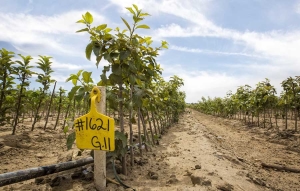
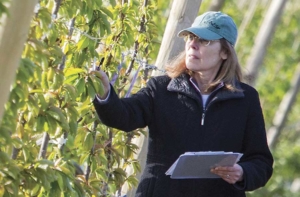





Leave A Comment